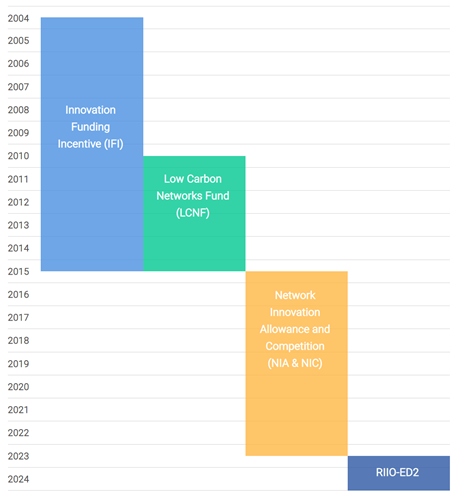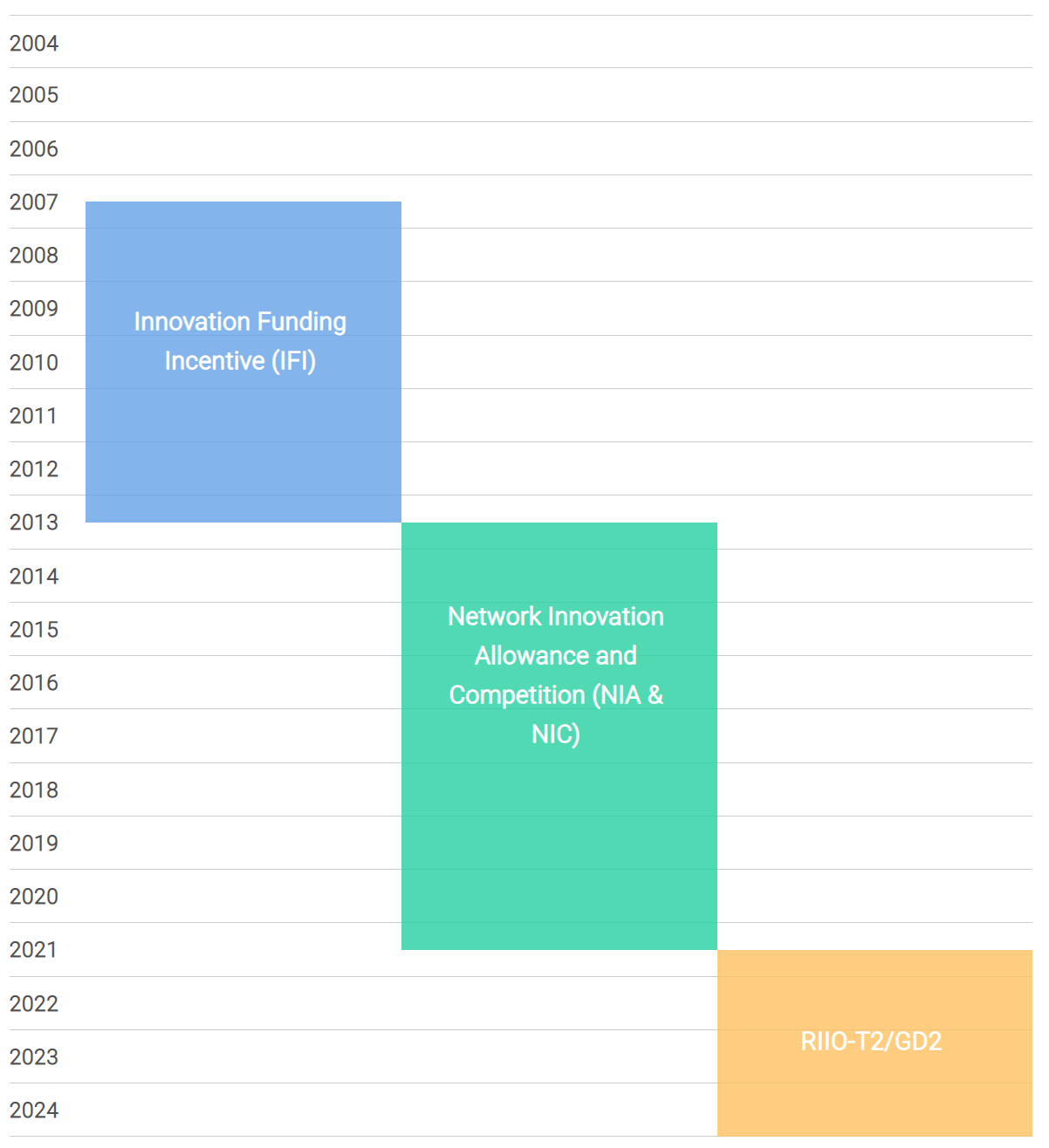Funding Timeline
Electricity Distribution Funding Timeline

Electricity Transmission and Gas Distribution and Transmission

Innovation Funding Incentive (IFI)
As part of the Distribution Price Control Review (DPCR) and Transmission Price Control Review (TPCR), Ofgem introduced the Innovation Funding Incentive (IFI) mechanism. IFI was consulted on as part of the DPCR and TPCR proposals.
The primary aim of the incentive is to encourage network operators to apply innovation in the technical development of their networks.
The IFI is intended to provide funding for projects primarily focused on the technical development of the networks, to deliver value (e.g. financial, quality of supply, environmental, safety) to consumers.
In April 2013, Ofgem replaced the Innovation Funding Incentive (IFI) with the Network Innovation Allowance (NIA) for operators of the gas and electricity transmission networks and gas distribution networks.
The IFI remained active for operators of the electricity distribution networks until April 2015, when we replaced it with the NIA.
Low Carbon Networks Fund (LCNF)
As part of the electricity distribution price control that ran until 31 March 2015, Ofgem established the Low Carbon Networks (LCN) Fund.
The LCN Fund allowed up to £500m to support projects sponsored by the Distribution Network Operators (DNOs) to try out new technology, operating and commercial arrangements. The aim of the projects is to help all DNOs understand how they can provide security of supply at value for money as Britain moves to a low carbon economy.
There are two tiers of funding under the LCN Fund. The First Tier allowed DNOs to recover a proportion of expenditure incurred on small scale projects. Under the Second Tier of the LCN Fund, we ran an annual competition for an allocation of up to £64 million to help fund a small number of flagship projects.
DNOs explore how networks can facilitate the take up of low carbon and energy saving initiatives such as electric vehicles, heat pumps, micro and local generation and demand side management. They also investigate the opportunities that smart meter roll-out provides to network companies. LCN Fund projects should provide valuable learning for the wider energy industry and other parties.
Ofgem are be monitoring the learning that emerges from these projects in order to understand its impact on the current regulatory framework.
Download LCNF Governance v7
Network Innovation Allowance and Competition (NIA & NIC)
NIA
As part of the RIIO price controls we have introduced the Network Innovation Allowance (NIA). The NIA is a set allowance each RIIO network licensee receives as part of their price control allowance.
The NIA provides limited funding to RIIO network licensees to use for two purposes:
- To fund smaller technical, commercial, or operational projects directly related to the licensees network that have the potential to deliver financial benefits to the licensee and its customers; and/or
- To fund the preparation of submissions to the Network Innovation Competition (NIC) which meet the criteria set out in the NIC Governance Document.
Download Electricity NIA Governance V3
Download Gas NIA Governance V3
Download Gas Problem Statements
NIC
As part of the RIIO price controls we introduced the Electricity Network Innovation Competition (NIC).
The NIC is an annual opportunity for both electricity and gas network companies to compete for funding for the development and demonstration of new technologies, operating and commercial arrangements. Funding will be provided for the best innovation projects which help all network operators understand what they need to do to provide environmental benefits, cost reductions and security of supply as Great Britain (GB) moves to a low carbon economy. Up to £81 million per annum is available through the Electricity NIC, and up to £18 million per annum is available through the Gas NIC.
Download Electricity NIC Governance V3
Download Gas NIC Governance V3
Download Gas Problem Statements
RIIO-T2/GD2/ED2
RIIO is Ofgem’s framework for setting price controls for network companies. Over the next decade these companies face an unprecedented challenge of securing significant investment to maintain a reliable and secure network, and dealing with the changes in demand and generation that will occur in a low carbon future.
As the regulator, we must ensure that this is delivered at a fair price for consumers. To help achieve this, we developed RIIO (Revenue=Incentives+ Innovation+Outputs), a new performance based model for setting the network companies’ price controls which will last eight years.
RIIO is designed to encourage network companies to:
- Put stakeholders at the heart of their decision-making process
- Invest efficiently to ensure continued safe and reliable services
- Innovate to reduce network costs for current and future consumers
- Play a full role in delivering a low carbon economy and wider environmental objectives.
RIIO-T2/GD2 represent the next price controls which start when RIIO-T1/GD1 ends in 2021, and RIIO-ED2 represent the next price controls which start when RIIO-ED1 ends in 2023.
